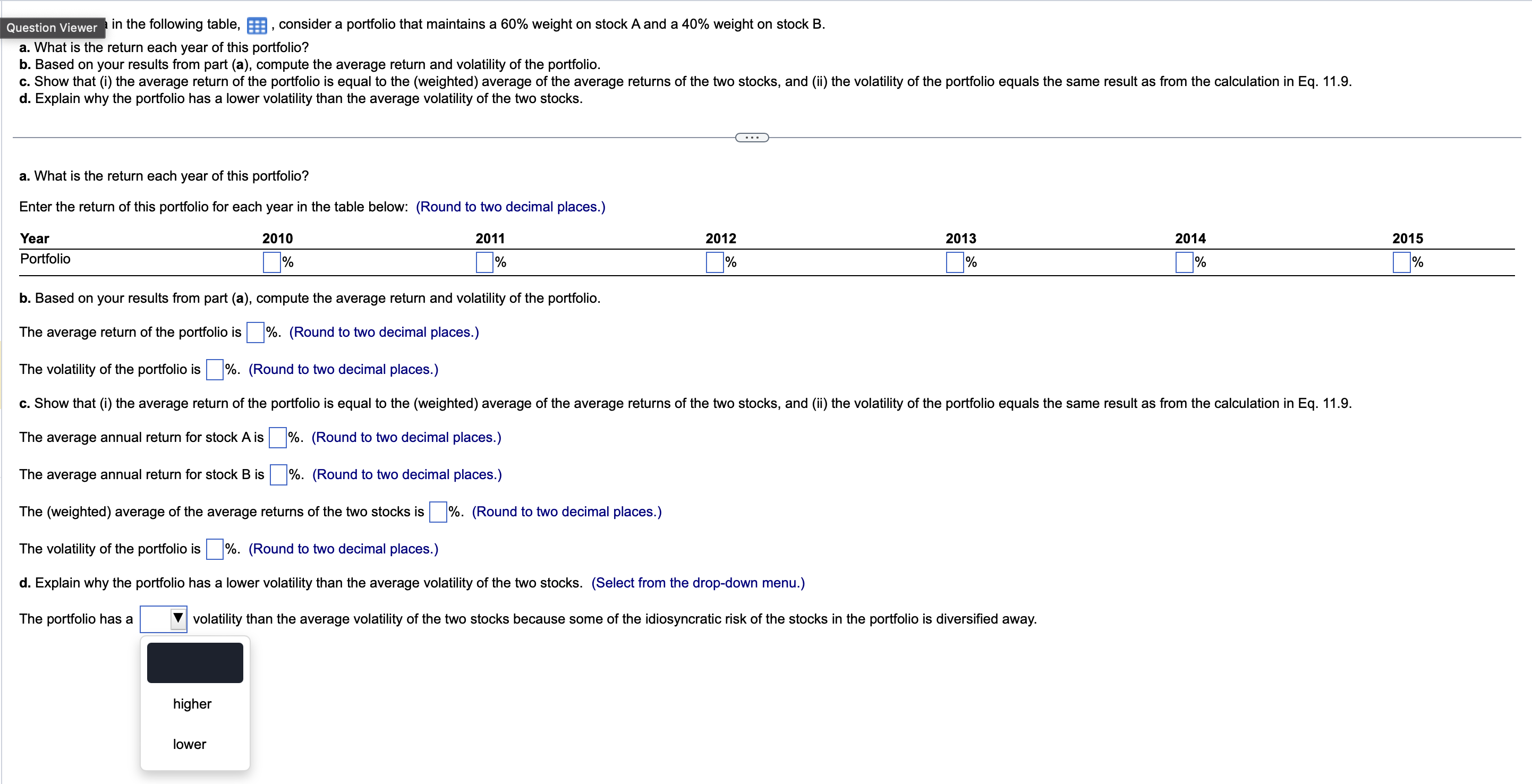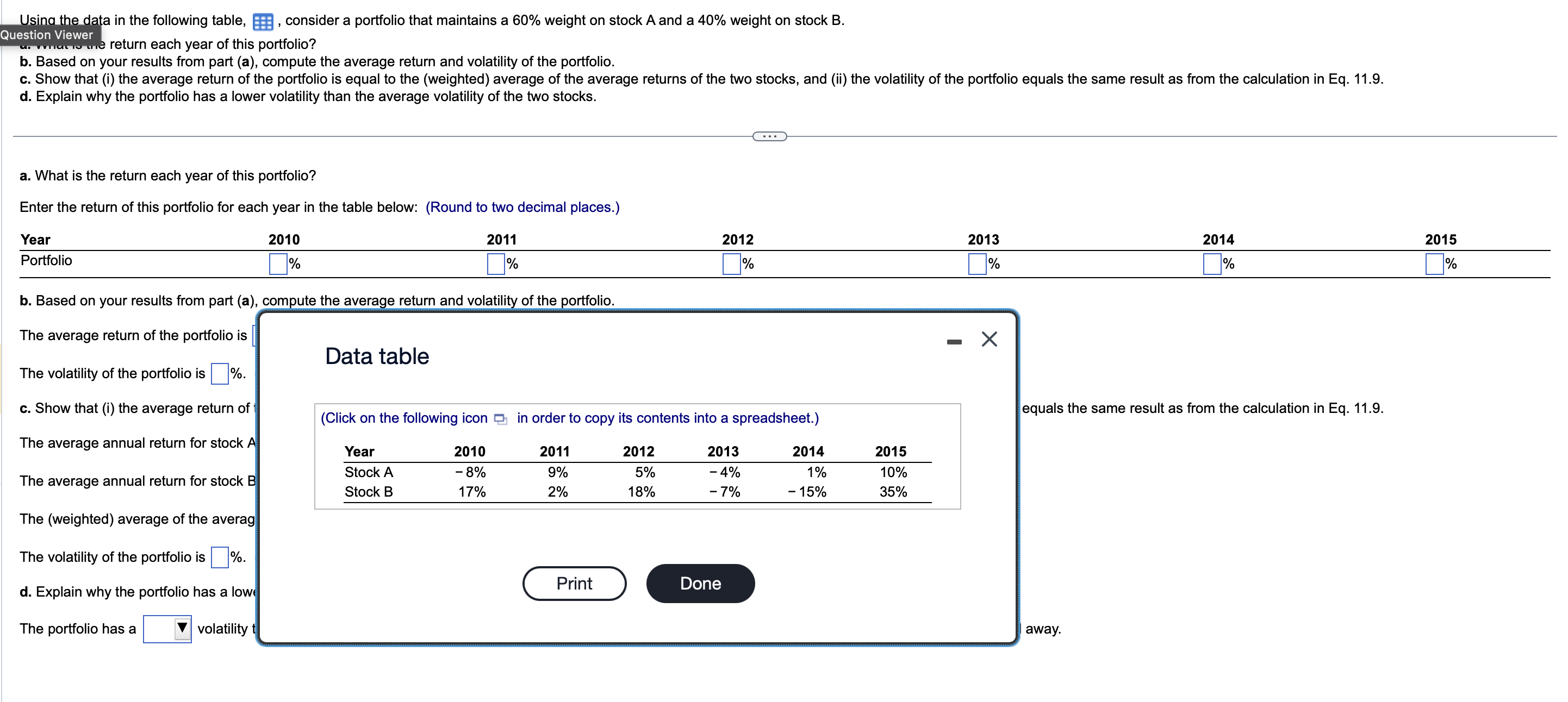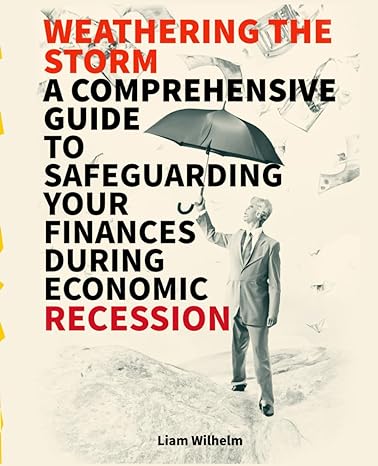Answered step by step
Verified Expert Solution
Question
1 Approved Answer
Question Viewer in the following table, consider a portfolio that maintains a 60% weight on stock A and a 40% weight on stock B. a.

 Question Viewer in the following table, consider a portfolio that maintains a 60% weight on stock A and a 40% weight on stock B. a. What is the return each year of this portfolio? b. Based on your results from part (a), compute the average return and volatility of the portfolio. d. Explain why the portfolio has a lower volatility than the average volatility of the two stocks. a. What is the return each year of this portfolio? Enter the return of this portfolio for each year in the table below: (Round to two decimal places.) Year Portfo b. Based on your results from part (a), compute the average return and volatility of the portfolio. The average return of the portfolio is %. (Round to two decimal places.) The volatility of the portfolio is 'o. (Round to two decimal places.) The average annual return for stock A is %. (Round to two decimal places.) The average annual return for stock B is ). (Round to two decimal places.) The (weighted) average of the average returns of the two stocks is \%. (Round to two decimal places.) The volatility of the portfolio is 'o. (Round to two decimal places.) d. Explain why the portfolio has a lower volatility than the average volatility of the two stocks. (Select from the drop-down menu.) The portfolio has a volatility than the average volatility of the two stocks because some of the idiosyncratic risk of the stocks in the portfolio is diversified away. Usina the data in the following table, , consider a portfolio that maintains a 60% weight on stock A and a 40% weight on stock B. Question Viewer rtfolio? b. Based on your results from part (a), compute the average return and volatility of the portfolio. d. Explain why the portfolio has a lower volatility than the average volatility of the two stocks. a. What is the return each year of this portfolio? Enter the return of this portfolio for each year in the table below: (Round to two decimal places.) 2012 2013 2014 2015 \begin{tabular}{lllll} 2012 & 2013 & 2014 & \\ \hline% & % & % & % \\ \hline \end{tabular} b. Based on your results from part (a), compute the average return and volatility of the portfolio. The average return of the portfolio is The volatility of the portfolio is Data table c. Show that (i) the average return of equals the same result as from the calculation in Eq. 11.9. The average annual return for stock A The average annual return for stock B The (weighted) average of the averag The volatility of the portfolio is J. d. Explain why the portfolio has a low The portfolio has a volatility away. Question Viewer in the following table, consider a portfolio that maintains a 60% weight on stock A and a 40% weight on stock B. a. What is the return each year of this portfolio? b. Based on your results from part (a), compute the average return and volatility of the portfolio. d. Explain why the portfolio has a lower volatility than the average volatility of the two stocks. a. What is the return each year of this portfolio? Enter the return of this portfolio for each year in the table below: (Round to two decimal places.) Year Portfo b. Based on your results from part (a), compute the average return and volatility of the portfolio. The average return of the portfolio is %. (Round to two decimal places.) The volatility of the portfolio is 'o. (Round to two decimal places.) The average annual return for stock A is %. (Round to two decimal places.) The average annual return for stock B is ). (Round to two decimal places.) The (weighted) average of the average returns of the two stocks is \%. (Round to two decimal places.) The volatility of the portfolio is 'o. (Round to two decimal places.) d. Explain why the portfolio has a lower volatility than the average volatility of the two stocks. (Select from the drop-down menu.) The portfolio has a volatility than the average volatility of the two stocks because some of the idiosyncratic risk of the stocks in the portfolio is diversified away. Usina the data in the following table, , consider a portfolio that maintains a 60% weight on stock A and a 40% weight on stock B. Question Viewer rtfolio? b. Based on your results from part (a), compute the average return and volatility of the portfolio. d. Explain why the portfolio has a lower volatility than the average volatility of the two stocks. a. What is the return each year of this portfolio? Enter the return of this portfolio for each year in the table below: (Round to two decimal places.) 2012 2013 2014 2015 \begin{tabular}{lllll} 2012 & 2013 & 2014 & \\ \hline% & % & % & % \\ \hline \end{tabular} b. Based on your results from part (a), compute the average return and volatility of the portfolio. The average return of the portfolio is The volatility of the portfolio is Data table c. Show that (i) the average return of equals the same result as from the calculation in Eq. 11.9. The average annual return for stock A The average annual return for stock B The (weighted) average of the averag The volatility of the portfolio is J. d. Explain why the portfolio has a low The portfolio has a volatility away
Question Viewer in the following table, consider a portfolio that maintains a 60% weight on stock A and a 40% weight on stock B. a. What is the return each year of this portfolio? b. Based on your results from part (a), compute the average return and volatility of the portfolio. d. Explain why the portfolio has a lower volatility than the average volatility of the two stocks. a. What is the return each year of this portfolio? Enter the return of this portfolio for each year in the table below: (Round to two decimal places.) Year Portfo b. Based on your results from part (a), compute the average return and volatility of the portfolio. The average return of the portfolio is %. (Round to two decimal places.) The volatility of the portfolio is 'o. (Round to two decimal places.) The average annual return for stock A is %. (Round to two decimal places.) The average annual return for stock B is ). (Round to two decimal places.) The (weighted) average of the average returns of the two stocks is \%. (Round to two decimal places.) The volatility of the portfolio is 'o. (Round to two decimal places.) d. Explain why the portfolio has a lower volatility than the average volatility of the two stocks. (Select from the drop-down menu.) The portfolio has a volatility than the average volatility of the two stocks because some of the idiosyncratic risk of the stocks in the portfolio is diversified away. Usina the data in the following table, , consider a portfolio that maintains a 60% weight on stock A and a 40% weight on stock B. Question Viewer rtfolio? b. Based on your results from part (a), compute the average return and volatility of the portfolio. d. Explain why the portfolio has a lower volatility than the average volatility of the two stocks. a. What is the return each year of this portfolio? Enter the return of this portfolio for each year in the table below: (Round to two decimal places.) 2012 2013 2014 2015 \begin{tabular}{lllll} 2012 & 2013 & 2014 & \\ \hline% & % & % & % \\ \hline \end{tabular} b. Based on your results from part (a), compute the average return and volatility of the portfolio. The average return of the portfolio is The volatility of the portfolio is Data table c. Show that (i) the average return of equals the same result as from the calculation in Eq. 11.9. The average annual return for stock A The average annual return for stock B The (weighted) average of the averag The volatility of the portfolio is J. d. Explain why the portfolio has a low The portfolio has a volatility away. Question Viewer in the following table, consider a portfolio that maintains a 60% weight on stock A and a 40% weight on stock B. a. What is the return each year of this portfolio? b. Based on your results from part (a), compute the average return and volatility of the portfolio. d. Explain why the portfolio has a lower volatility than the average volatility of the two stocks. a. What is the return each year of this portfolio? Enter the return of this portfolio for each year in the table below: (Round to two decimal places.) Year Portfo b. Based on your results from part (a), compute the average return and volatility of the portfolio. The average return of the portfolio is %. (Round to two decimal places.) The volatility of the portfolio is 'o. (Round to two decimal places.) The average annual return for stock A is %. (Round to two decimal places.) The average annual return for stock B is ). (Round to two decimal places.) The (weighted) average of the average returns of the two stocks is \%. (Round to two decimal places.) The volatility of the portfolio is 'o. (Round to two decimal places.) d. Explain why the portfolio has a lower volatility than the average volatility of the two stocks. (Select from the drop-down menu.) The portfolio has a volatility than the average volatility of the two stocks because some of the idiosyncratic risk of the stocks in the portfolio is diversified away. Usina the data in the following table, , consider a portfolio that maintains a 60% weight on stock A and a 40% weight on stock B. Question Viewer rtfolio? b. Based on your results from part (a), compute the average return and volatility of the portfolio. d. Explain why the portfolio has a lower volatility than the average volatility of the two stocks. a. What is the return each year of this portfolio? Enter the return of this portfolio for each year in the table below: (Round to two decimal places.) 2012 2013 2014 2015 \begin{tabular}{lllll} 2012 & 2013 & 2014 & \\ \hline% & % & % & % \\ \hline \end{tabular} b. Based on your results from part (a), compute the average return and volatility of the portfolio. The average return of the portfolio is The volatility of the portfolio is Data table c. Show that (i) the average return of equals the same result as from the calculation in Eq. 11.9. The average annual return for stock A The average annual return for stock B The (weighted) average of the averag The volatility of the portfolio is J. d. Explain why the portfolio has a low The portfolio has a volatility away Step by Step Solution
There are 3 Steps involved in it
Step: 1

Get Instant Access to Expert-Tailored Solutions
See step-by-step solutions with expert insights and AI powered tools for academic success
Step: 2

Step: 3

Ace Your Homework with AI
Get the answers you need in no time with our AI-driven, step-by-step assistance
Get Started


